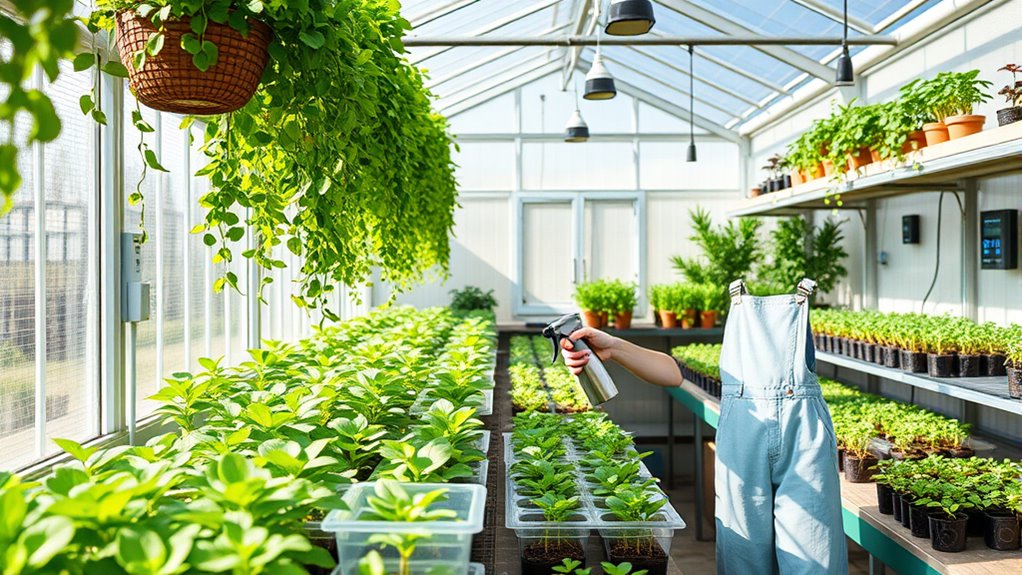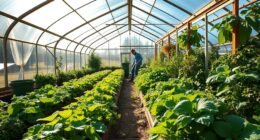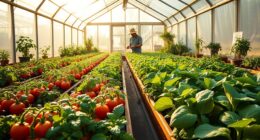To keep your greenhouse healthy, perform daily tasks like watering your plants based on their needs, checking for pests and removing debris, and monitoring the environment with a thermometer and hygrometer. Maintain good airflow, inspect plants for early issues, and adjust ventilation or shading as needed. Staying consistent with these simple routines helps prevent problems and supports healthy growth. Keep going to uncover more tips for mastering your greenhouse care.
Key Takeaways
- Conduct daily inspections for pests, health issues, and environmental conditions to catch problems early.
- Check soil moisture levels regularly using a moisture meter and water plants accordingly.
- Remove dead leaves and debris daily to maintain cleanliness and prevent pest habitats.
- Monitor temperature and humidity with gauges and adjust ventilation or shading as needed.
- Ensure all equipment, like fans and heaters, are functioning properly to sustain optimal growing conditions.

Are you new to greenhouse gardening? If so, establishing a solid routine is vital to keep your plants healthy and thriving. One of your first tasks should be setting a consistent watering schedule. Plants in a greenhouse often require more frequent watering than outdoor gardens because the environment traps heat and humidity, which can cause the soil to dry out quickly. Pay close attention to the specific needs of your plants; some may prefer moist soil, while others thrive when the top layer dries out between waterings. Using a moisture meter can help you determine exactly when your plants need water, preventing both overwatering and underwatering. Overwatering can lead to root rot and other diseases, while underwatering stresses the plants and hampers growth. Developing a reliable watering routine guarantees your plants receive the right amount of moisture consistently. Incorporating Gold IRA Rollovers into your retirement planning can provide long-term financial stability, just as consistent care ensures healthy plants.
Another vital aspect of daily greenhouse care is pest prevention. Regular inspection is key—look for signs of pests such as discolored leaves, holes, or sticky residues. Catching issues early makes treatment easier and more effective. To prevent pests from taking hold, maintain cleanliness inside your greenhouse; remove dead leaves and debris that can harbor insects. You should also ensure proper airflow, as stagnant air creates ideal conditions for pests and diseases to develop. Introducing natural predators or beneficial insects, like ladybugs or predatory mites, can help keep pest populations in check without resorting to chemicals. Keep an eye on your plants’ health to spot any early signs of infestation, and take swift action when needed. Preventative measures go a long way in avoiding major pest problems that could compromise your entire crop.
Daily tasks should also include monitoring temperature and humidity levels. Using a thermometer and hygrometer allows you to adjust ventilation, shading, or heating as necessary. Proper climate control helps prevent pests and diseases, and keeps your plants comfortable. Additionally, check your greenhouse’s ventilation system regularly to ensure it’s working correctly—good airflow not only reduces humidity but also discourages pests from settling in. Consistent maintenance and observation are your best tools in day-to-day greenhouse care. By sticking to a routine that includes watering schedules, pest prevention, and environmental monitoring, you set a foundation for a successful growing season. These small, daily actions build a healthy environment where your plants can flourish, making your greenhouse a productive and enjoyable space.
Frequently Asked Questions
How Do I Prevent Pests in My Greenhouse?
To prevent pests in your greenhouse, start with regular pest inspections to catch issues early. Keep your environment clean and remove dead plant material. Introduce beneficial insects like ladybugs or predatory mites to naturally control pests. Make certain proper airflow and avoid overwatering, which can attract pests. By staying vigilant and promoting a healthy environment, you can minimize pest problems and keep your plants thriving naturally.
What’s the Best Way to Control Humidity Levels?
To regulate humidity levels, you should regularly monitor your greenhouse’s humidity and adjust accordingly. Use a humidifier and maintain it properly to prevent excess moisture. Employ misting techniques during dry periods to increase humidity without overdoing it. Ventilate your greenhouse by opening vents or doors to lower humidity when it gets too high. Consistent humidifier maintenance helps guarantee ideal moisture levels, creating a healthy environment for your plants.
How Often Should I Fertilize My Plants?
You should fertilize your plants every 1-2 weeks, but it’s essential to check soil testing results first. Regular testing helps you monitor nutrient balance and adjust your fertilization schedule accordingly. Over-fertilizing can harm your plants, so always follow the recommended dosage based on your soil’s nutrient levels. During active growth, more frequent feeding might be needed, while in dormancy, cut back to maintain a healthy, balanced environment.
When Is the Ideal Time to Prune?
Did you know that proper pruning can increase plant growth by up to 30%? The ideal timing for pruning depends on your plant’s species, but generally, you should prune during its active growth season or after flowering. Use effective pruning techniques like thinning and heading cuts, and avoid pruning during dormancy. This guarantees healthy growth and better yields, making your greenhouse thrive.
How Can I Extend the Growing Season?
To extend your growing season, you can implement season extension techniques like using row covers, thermal blankets, or installing supplemental lighting. Additionally, practicing crop rotation helps maintain soil health and reduces pests, which supports longer growth periods. Keep an eye on weather forecasts, and don’t hesitate to modify your environment by increasing insulation or heating. These strategies ensure your plants thrive longer and maximize your greenhouse’s productivity.
Conclusion
Taking care of your greenhouse daily keeps your plants healthy and thriving. Remember, spending just 15 minutes each day on watering, inspecting, and maintaining your space makes a big difference. Did you know that consistent care can boost plant growth by up to 30%? By staying attentive and routine, you’ll enjoy lush, vibrant plants and a rewarding gardening experience. Keep it simple, stay committed, and watch your greenhouse flourish with your dedication.









